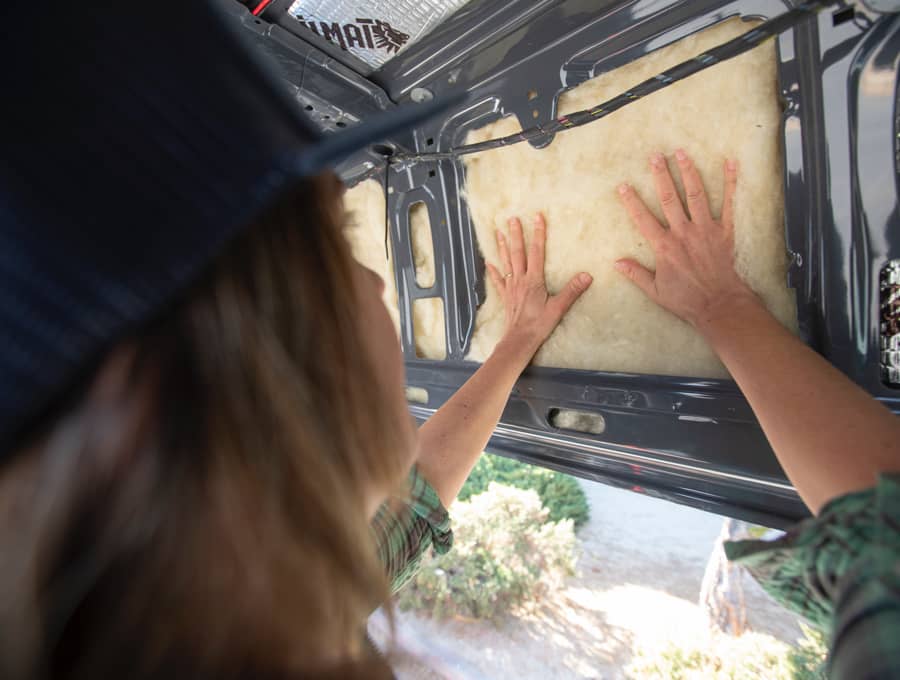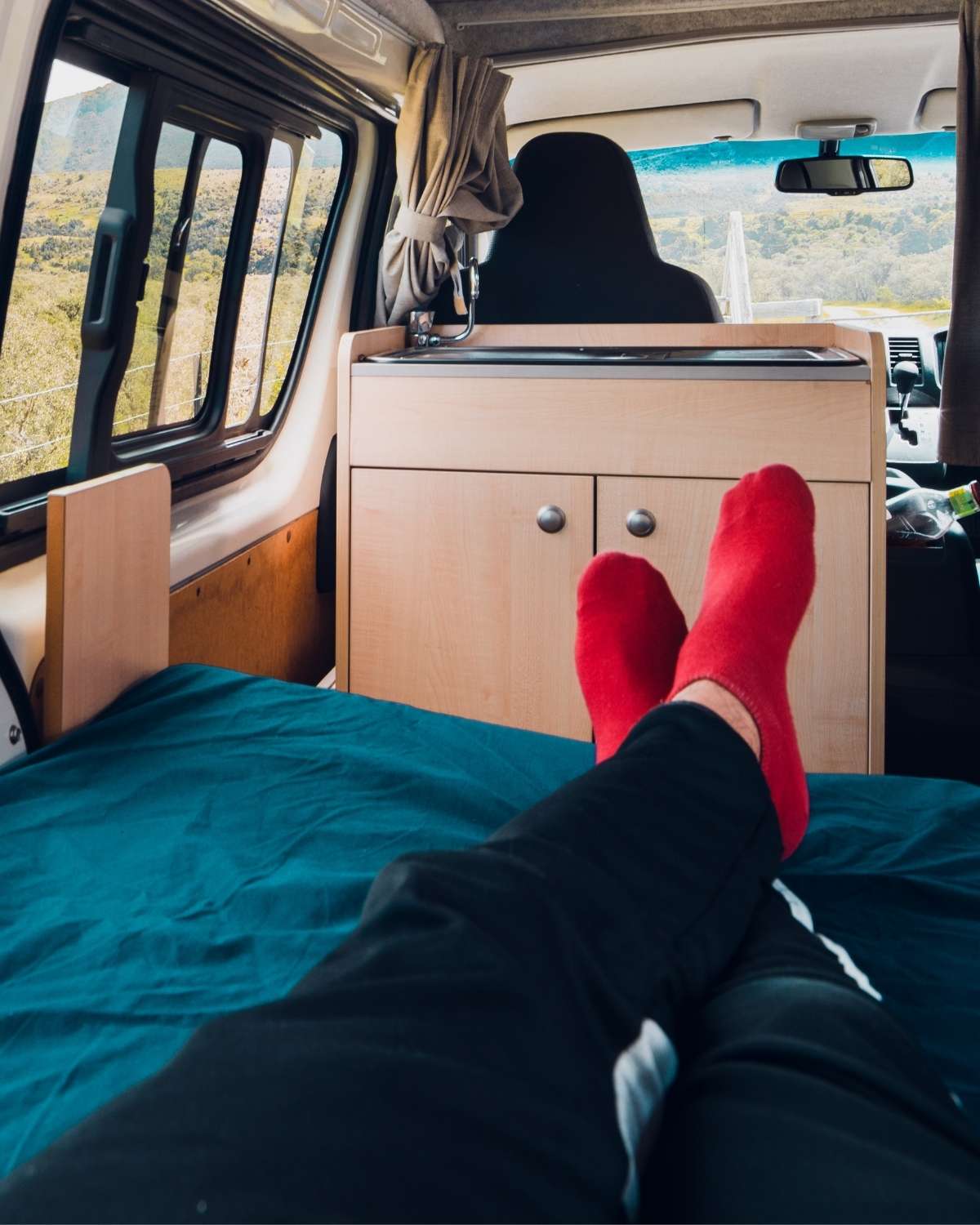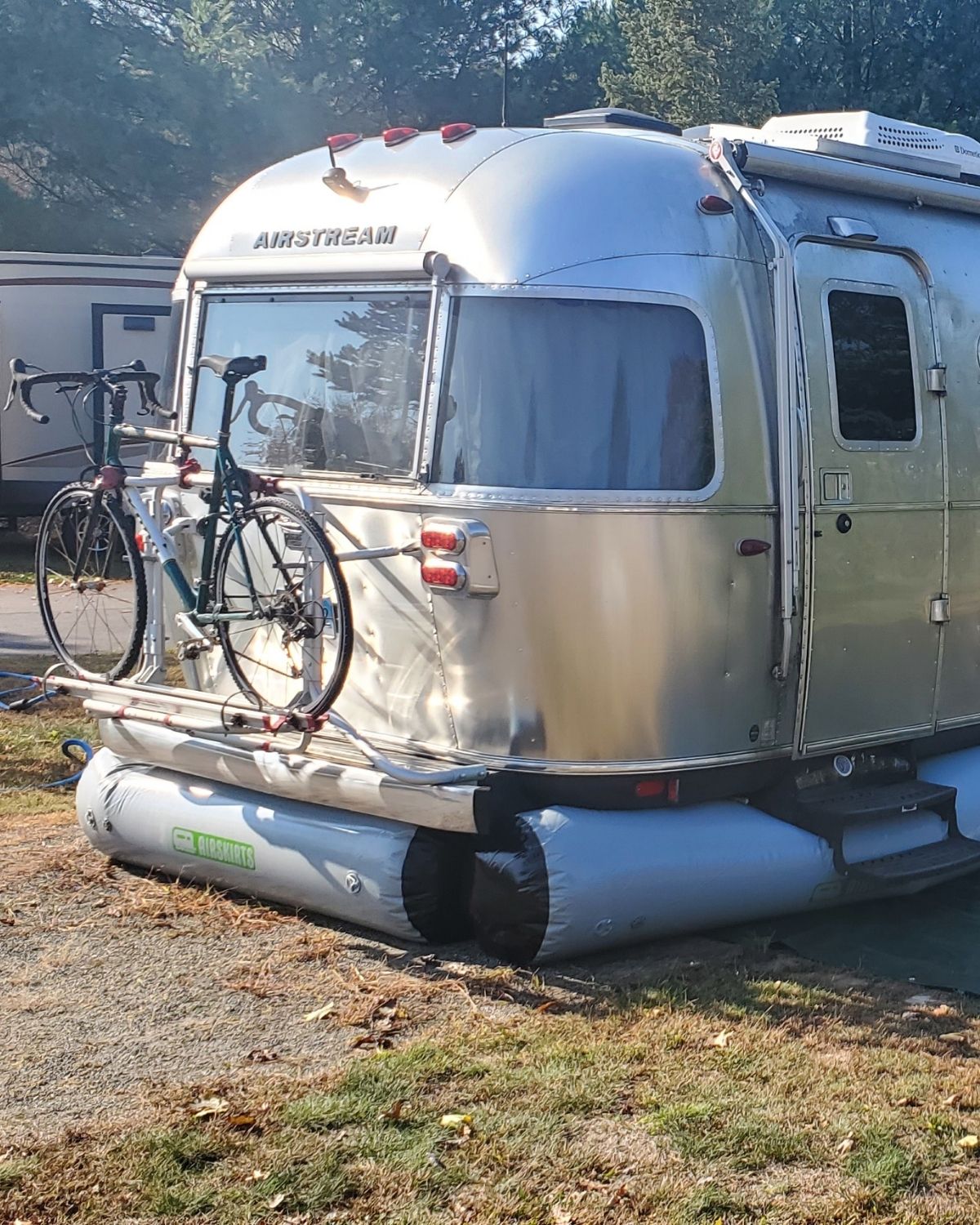Unlock the ultimate comfort in your campervan with our in-depth guide on insulation for a van. Explore top insulation choices, expert tips, and transform your camper into a year-round adventure machine, ready to face any climate with ease!
Did you know that insulating your van can not only make your travels more comfortable but also save you money on fuel and heating costs?
In this ultimate DIY guide, we’ll dive into the world of insulation for a van camper, covering everything from the importance of insulation to various materials and even providing a step-by-step guide to insulating your van.
- Insulation is essential for a comfortable van life experience, and there are multiple types of insulation materials to choose from.
- Make sure to measure, cut and install the insulation correctly in different areas like flooring, walls, ceiling & windows.
- Tips such as RV skirting & reflective window coverings can help you stay comfortable while saving on costs.
Get ready to enjoy a cozier, quieter, and more energy-efficient van life!
When you click on links to various merchants on this site and make a purchase, this can result in this site earning a commission. As Amazon Associates, we earn from qualifying purchases. For more info, please check our disclosure page.
Understanding the Importance of Van Insulation
When you buy a van to convert, it may have little or no insulation installed. It may have started life as a courier van or something similar.
It never needed to be warm and cozy because it was never intended as a home. Now you want to convert it to a comfortable camper van.
So how do you turn a metal shell into a home to keep you warm in the cold and cool in the heat?
Decent insulation, combined with good ventilation and sound deadening, can create an environment anyone would be proud to call home.
Insulation plays a crucial role in keeping you comfortable when living or traveling in a van.
Why?
Heat transfer takes place through three different modes:
- radiation,
- conduction and
- convection.
All these modes are essential for efficient heat transfer.
Insulation helps slow this heat transfer, keeping the warm air inside the van during colder months.
In hot climates, insulation helps reflect radiant heat, preventing the van from turning into a sauna.
Moisture resistance is another key factor in van insulation, as it helps prevent mold growth and damage to your insulation materials.
Furthermore, considering toxicity when selecting van insulation is essential, as it can lead to respiratory aggravators or health risks in a confined area.
Ensuring proper insulation also helps with energy efficiency, reducing heating and cooling costs.
So, how exactly does insulation work?
Let’s take a look at RV windows, the biggest culprit when it comes to losing heat in a van during winter camping.
Sealing the RV windows is vital to keep the warm air inside and prevent cold air from entering.
It’s essential to check and repair the caulking in the windows and apply rubber conditioner to the weather stripping.
Understanding the concept of thermal break is also important in van insulation.
A thermal break occurs when you use non-conductive materials, like insulation, to block heat flow in a thermal bridge.
This helps maintain a steady temperature inside the van, making your living space comfortable.
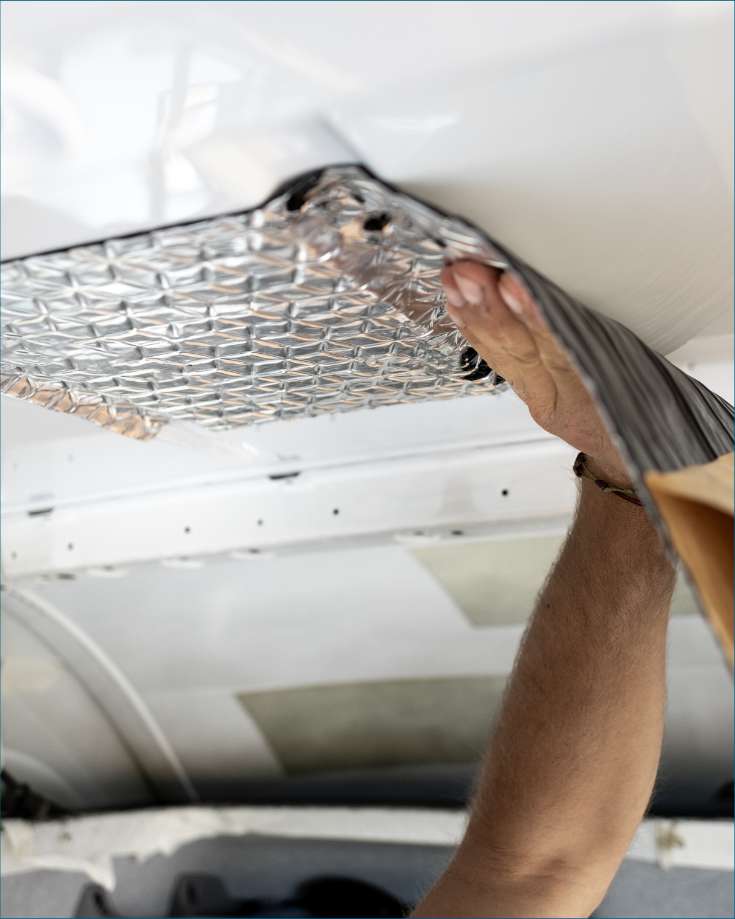
R-Values & Heat Value per Inch
R-value measures thermal resistance, indicating insulation’s effectiveness in preventing heat transfer.
It represents how well a material resists the flow of heat through it.
The higher the R-value, the better the insulating properties of the material, and the more effective it is at keeping heat in during cold weather and keeping heat out during hot weather.
Heat value per inch refers to the amount of heat resistance an insulating material provides for every inch of thickness.
This metric helps compare the performance of different insulation materials when applied in various thicknesses.
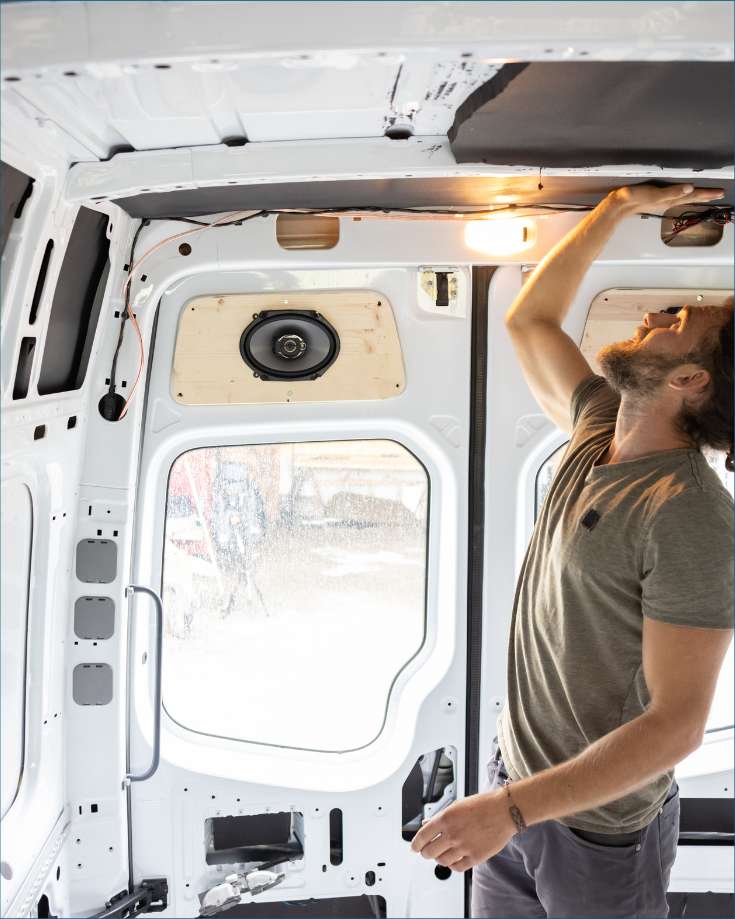
R-values and heat value per inch are relevant to van insulation for the following reasons:
Energy Efficiency
Choosing insulation with higher R-values and heat value per inch ensures that your van’s interior maintains a comfortable temperature with minimal energy consumption.
This is particularly important for those who rely on battery power or solar panels to provide electricity for heating or cooling systems in their van.
Space Optimization
In a van conversion, space is often limited.
Selecting insulation materials with higher R-values and heat value per inch allows you to use thinner insulation layers while still achieving optimal thermal performance.
This helps maximize the living space within the van.
Temperature Regulation
A well-insulated van with materials boasting high R-values and heat value per inch can effectively regulate interior temperatures, keeping you comfortable during both hot and cold weather.
This is crucial for those who plan to travel to destinations with varying climates or spend extended periods in their van.
When choosing insulation for your van conversion, consider the R-value and heat value per inch of the various materials available.
By selecting materials with higher values, you can optimize your van’s energy efficiency, space utilization, and temperature regulation, ensuring a more comfortable and enjoyable experience during your travels.
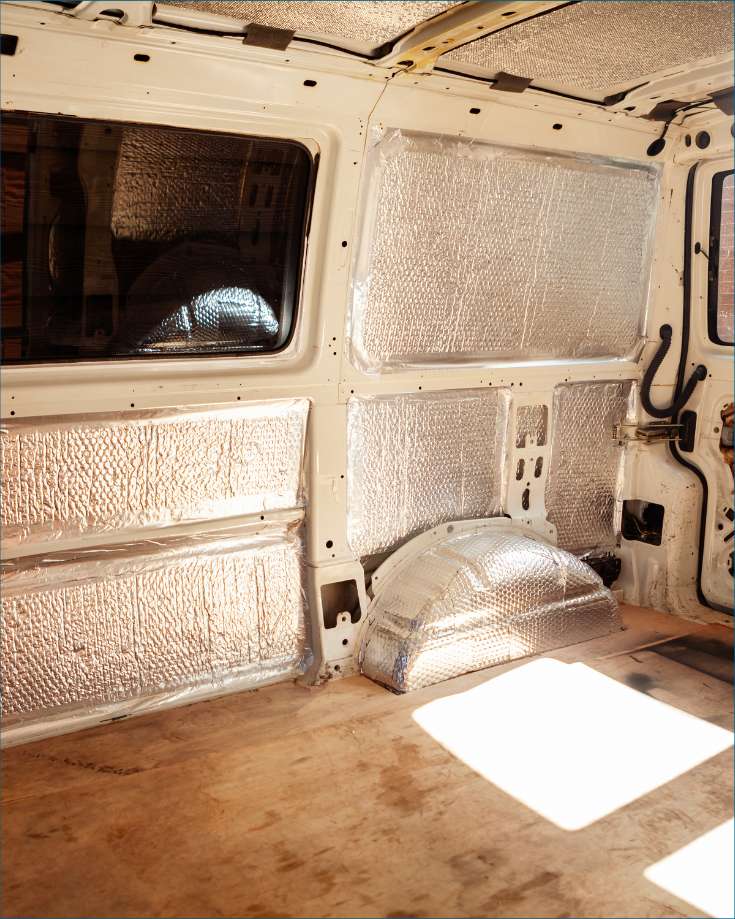
Types of Van Insulation Materials
Various types of insulation materials are suitable for camper vans, each with advantages and disadvantages.
The best choice for your van conversion depends on factors such as cost, insulation quality, and environmental impact.
Foam Board Insulation
Foam board insulation is a popular choice for van conversions due to its many benefits.
It’s lightweight, moisture-resistant, affordable, non-toxic, and fire-resistant and comes in different thicknesses.
It is an excellent choice for insulating the ceiling and floor of a van conversion.
There are different types of foam board insulation, such as Polyisocyanurate (PIR) and Extruded Polystyrene (XPS).
PIR has a higher R-value (a measure of thermal resistance) than XPS, making it a more effective insulator.
Production of XPS emits HFCs, which are incredibly damaging greenhouse gases. In comparison to CO2, they cause much more global warming.
When installing foam board insulation, it is crucial to ensure proper installation to avoid trapping moist air behind the insulation, which can lead to mold and mildew growth.
Cutting the insulation to fit your van’s unique shapes and curves can be challenging, but the effort is well worth the benefits it provides.
Reflective Insulation
Reflective insulation, such as Reflectix, is another option for van conversions.
Reflectix is a thin bubble wrap with a reflective coating on each side.
This reflective coating works as a radiant heat barrier. While it is excellent at reflecting heat, its effectiveness is greatly reduced when it is applied directly onto the van’s metal walls or has something on top of it.
The proper use of Reflectix in van insulation requires an air gap between the van’s metal walls and the Reflectix to make it an effective radiant barrier.
It’s not recommended for use as the main insulation method in a van conversion, but it can be useful as a window cover.
Other radiant barrier options include EZ-Cool, Insul-Shine, and Eclipse Sunshade, providing similar benefits to Reflectix.
EZ-Cool has a number of advantages over Reflectix.
It has a closed-cell foam center which gives it a higher R-value than Reflectix’s bubble wrap insulation.
EZ-Cool is suggested for use in window covers.
Natural Insulation Options
If you’re looking for eco-friendly insulation options for your van conversion, natural insulation materials such as sheep wool, denim, and recycled polyester are excellent choices.
These materials are breathable and help with moisture control, making them suitable for van conversions.
Sheep wool insulation is a popular natural option due to its excellent insulating properties, moisture management, fire resistance, pest resistance, non-toxicity, and ease of use.
However, it requires more quantity than foam insulation, which can increase the overall cost.
Denim insulation, made from recycled denim clothes, is another natural option with decent insulating properties.
However, it is essential to use a completely sealed vapor barrier or excellent ventilation when using denim insulation, as it is highly absorbent of moisture and can become a hotspot for mites if not covered up.
Hemp Wool, an eco-friendly and vegan insulation, is another natural option worth considering.
It has great insulating properties, non-toxicity, biodegradability, and excellent moisture management.
However, its Class-E fire resistance rating is a significant drawback.
Spray Foam Insulation
Spray foam insulation is often praised for its high R-value rating, making it an incredibly efficient insulation material.
However, applying it can be quite messy and costly if you opt for professional installation.
We decided against using it in our van conversion, and here’s why:
I once heard a story about a man who waited nine months for his brand-new Sprinter van to arrive.
As soon as he got it, he hired a professional spray foam insulation company to insulate his vehicle.
Unfortunately, later that day, he shared photos of his severely damaged panels on his pristine new van.
It turns out that the spray foam used by some companies, especially those intended for filling cavities in houses, can generate intense heat during application and expand significantly.
It’s unclear whether the van had interior panels installed and the cavities were filled or if the foam was applied directly onto the interior panels.
Regardless, the panels became warped, leaving the owner extremely frustrated.
I also had a negative experience with spray foam insulation from a local hardware store when I attempted to fill gaps around my home’s front door.
It took 20 minutes to apply, but cleaning the bright green, expanded foam from the brickwork and door frames took two full days.
Spray foam insulation might be useful for filling gaps in panel ridge frames, but once it’s in, it’s there to stay.
This means you lose the option to run cables or service pipes in the future.
Frankly, it’s just too messy for my taste.
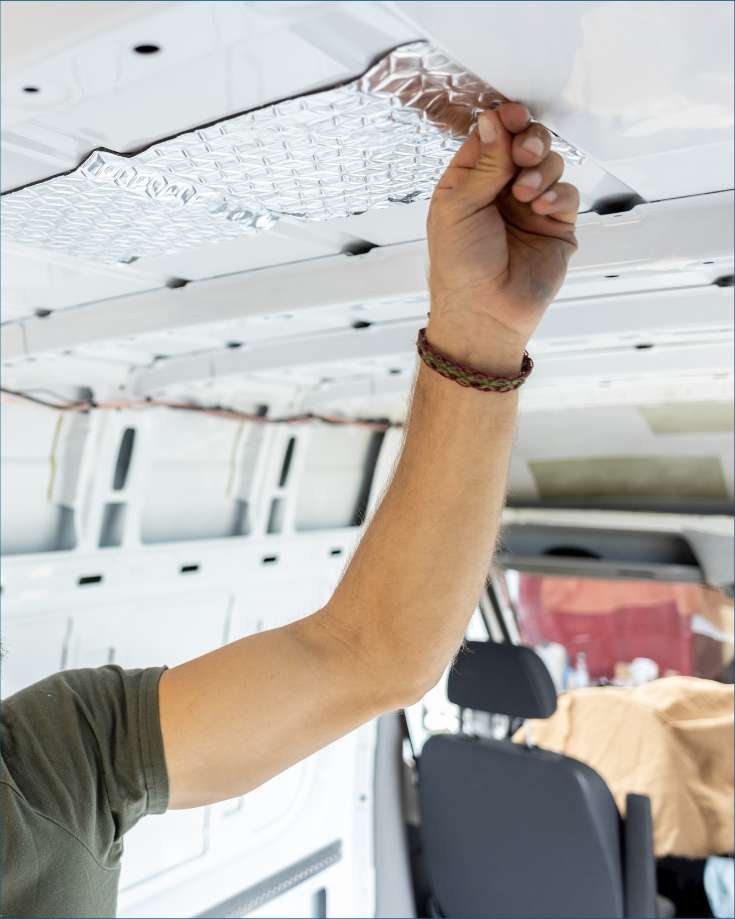
Synthetic Insulation Options
Synthetic insulation options like Thinsulate and 3M are more expensive than other alternatives but offer excellent insulating properties.
Thinsulate is often used in outdoor clothing garments to keep you warm and is also used in vans for sound deadening, moisture resistance, and flame resistance.
3M Thinsulate SM 600L is another synthetic option with an R-value of 5.2 per inch.
It’s non-toxic and easy to work with.
It’s also fire and pest resistant, great at deadening sound, and excellent at moisture management.
However, it has a lower R-value per inch than other insulation materials and is much pricier than alternatives like sheep wool.
Ceramic paint is sometimes mentioned as a potential insulation option for vans, but no scientific evidence supports its effectiveness in insulating vans.
We recommend using proven insulation materials like foam board and natural and synthetic options when insulating your van.
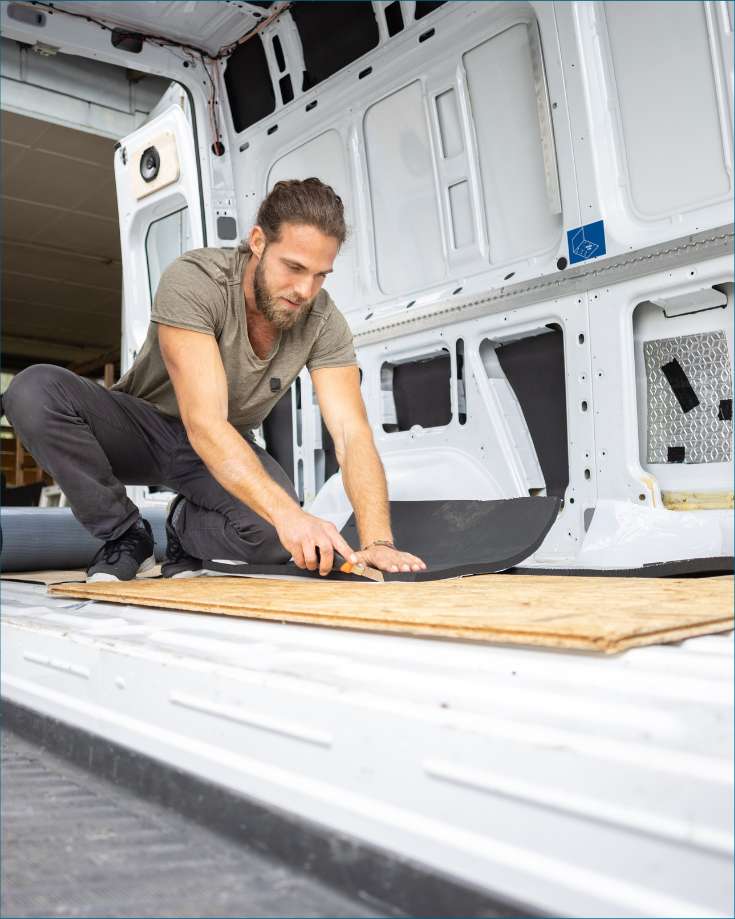
Insulating Different Areas of Your Van
Insulating your van is not a one-size-fits-all process, as different areas of the van require different types of insulation.
In this section, we will explore how to insulate your van’s floor, ceiling, walls, and windows using various materials and techniques tailored to each area.
Floor Insulation
Floor insulation is essential in a van conversion, as it helps reduce heat loss and prevents cold air from entering the van.
Polyisocyanurate (PIR) insulation is a great choice for van floors, as it is easy to install and provides excellent thermal resistance.
When insulating the floor, it is crucial to measure and cut the insulation to fit your van’s unique shapes and curves.
This ensures no exposed metal surfaces and prevents gaps where moist air could get trapped.
The plywood thickness used for the van floor is typically 9mm, so be sure to consider this when cutting your insulation.
Gluing batons down instead of using screws is also recommended, as it reduces the number of holes you need to make in the van.

Ceiling Insulation
Ceiling insulation is important in a van conversion, as it helps reduce heat loss and improve indoor comfort.
High R-rated insulation materials are recommended for the ceiling, as they provide excellent thermal resistance and help keep the van warm in cold temperatures.
Again, measure and cut the insulation to fit your van’s unique shapes and curves, ensuring there are no exposed surfaces.
The installation process for ceiling insulation typically involves fitting batons to the roof ribs, adding furring strips, and installing a vapor barrier. See more on that below.
Be sure to follow the manufacturer’s instructions when installing the insulation to ensure the best performance.
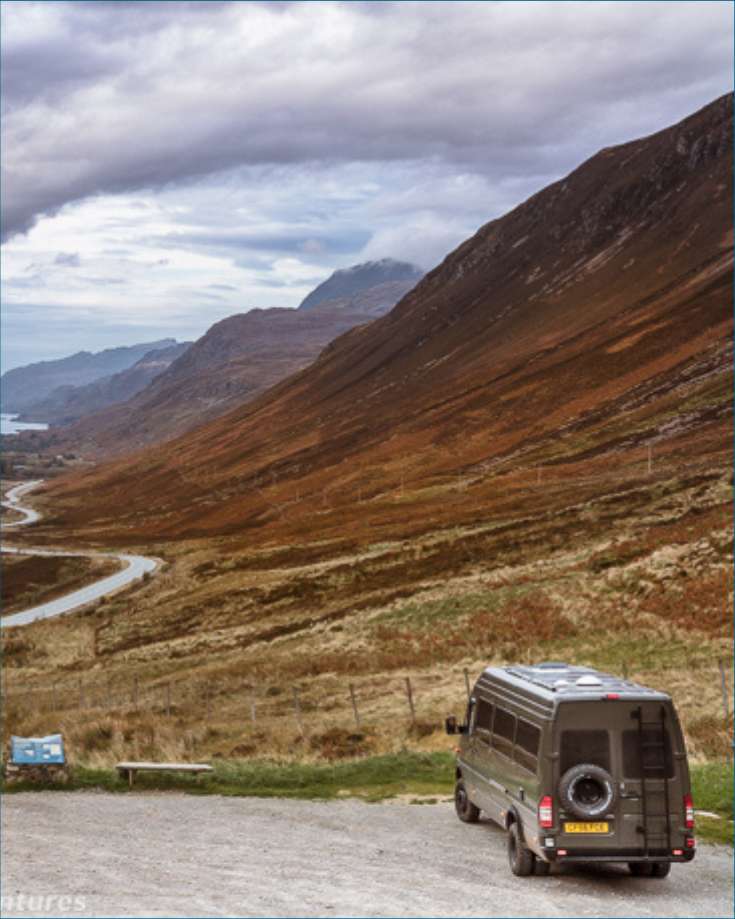
Wall Insulation
Wall insulation is important in van conversions, as it helps reduce heat loss and improve indoor comfort.
Polyester insulation is an excellent choice for van walls due to its insulating properties, moisture management, and ease of use.
Once again, fit the insulation to the curves of your van and cover all exposed surfaces.
Packing the walls with polyester eco-wool insulation is a great way to insulate your van walls, as it is easy to work with and provides excellent thermal resistance.
Foam insulation can also be used in hard-to-reach areas of the van, where polyester eco-wool insulation may not be suitable.
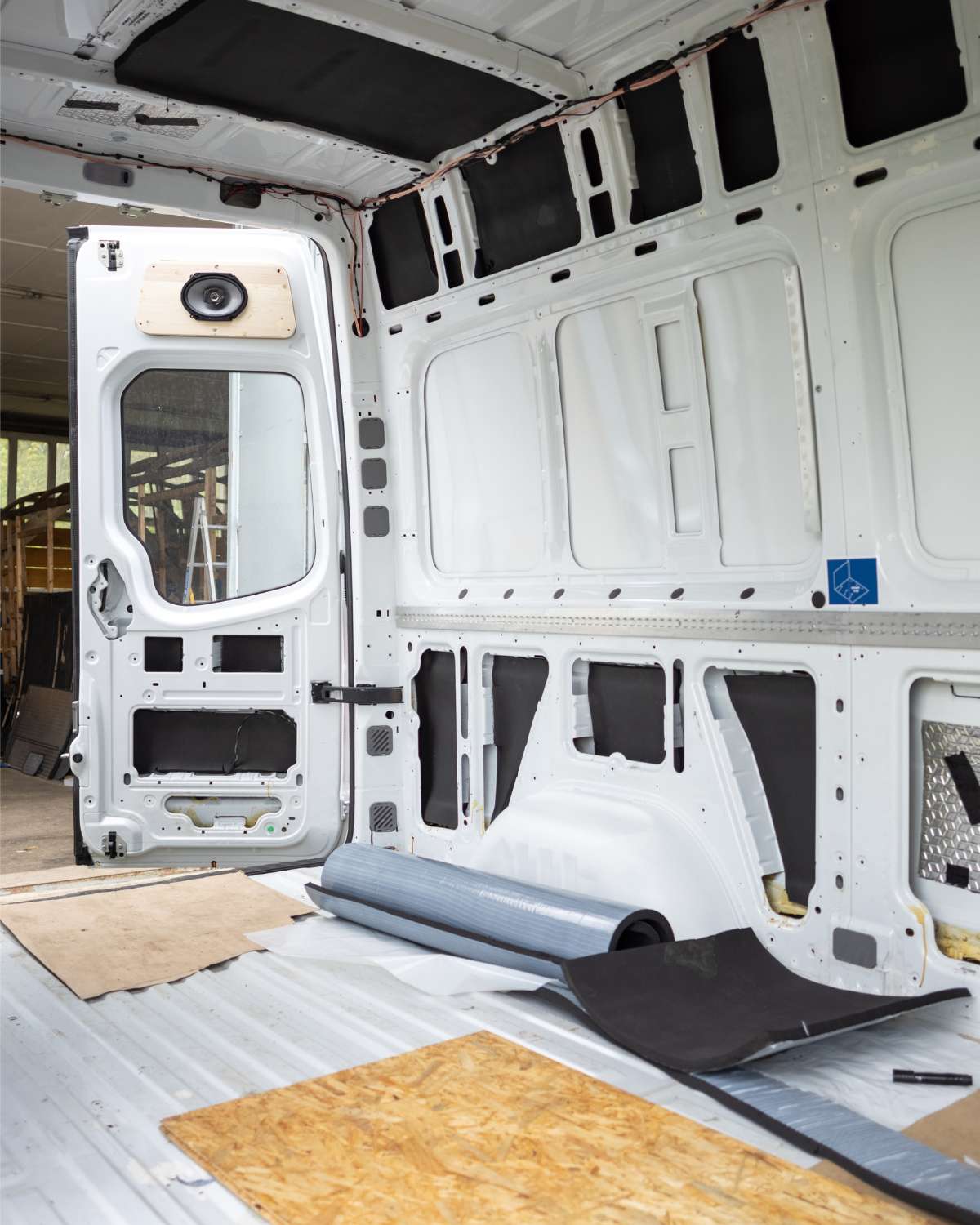
Window Insulation
Window insulation is important, especially in a van with many windows like our converted Sprinter minibus.
Reflectix is a great choice for window insulation, providing an effective radiant barrier when used with an air gap.
Installing curtains made from insulating thermal fabric is another excellent way to insulate your van windows. These curtains not only provide insulation but also help with privacy and light control.
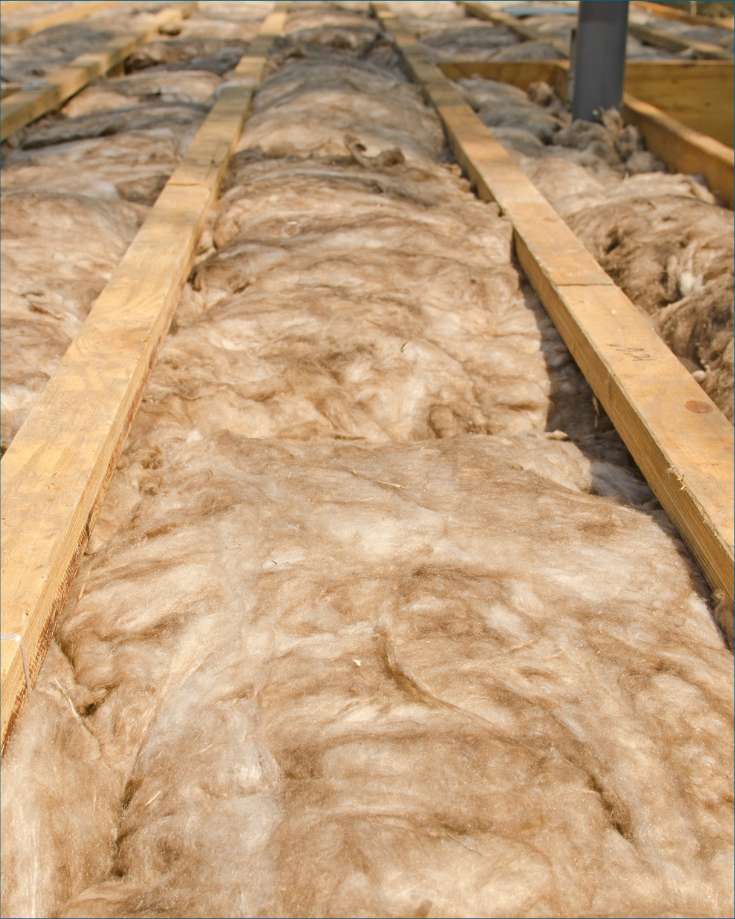
Vapor Barriers and Moisture Management
Vapor barriers can play a role in van insulation by preventing moisture from causing rust and damage to your insulation materials.
However, there is a debate surrounding the necessity of vapor barriers in van builds, as some argue that permeability and proper ventilation will adequately manage moisture without the need for a vapor barrier.
We believe a vapor barrier isn’t necessary. If anything, it can be more damaging.
Achieving a completely sealed vapor barrier in a van conversion is nearly impossible due to the unique construction and design challenges.
Vans have a complex structure with numerous curves, angles, and irregular surfaces.
Sealing a vapor barrier around these irregularities can be challenging, requiring meticulous cutting and fitting of the barrier material.
Even with careful installation, small gaps or imperfections may remain, allowing moisture to penetrate the barrier.
Plus, a typical van conversion includes numerous fittings that protrude through the interior walls, including electrical wiring and plumbing.
Each of these creates a potential weak point in the vapor barrier, making it difficult to achieve a completely airtight seal.
When moisture gets behind the vapor barrier – and it will – the barrier prevents the ventilation system from drying out.
Managing moisture is essential for preventing mold and mildew growth, as well as ensuring the longevity of your van insulation.
Whether or not you choose to use a vapor barrier, installing your insulation materials correctly and ensuring adequate ventilation to keep moisture under control is crucial.
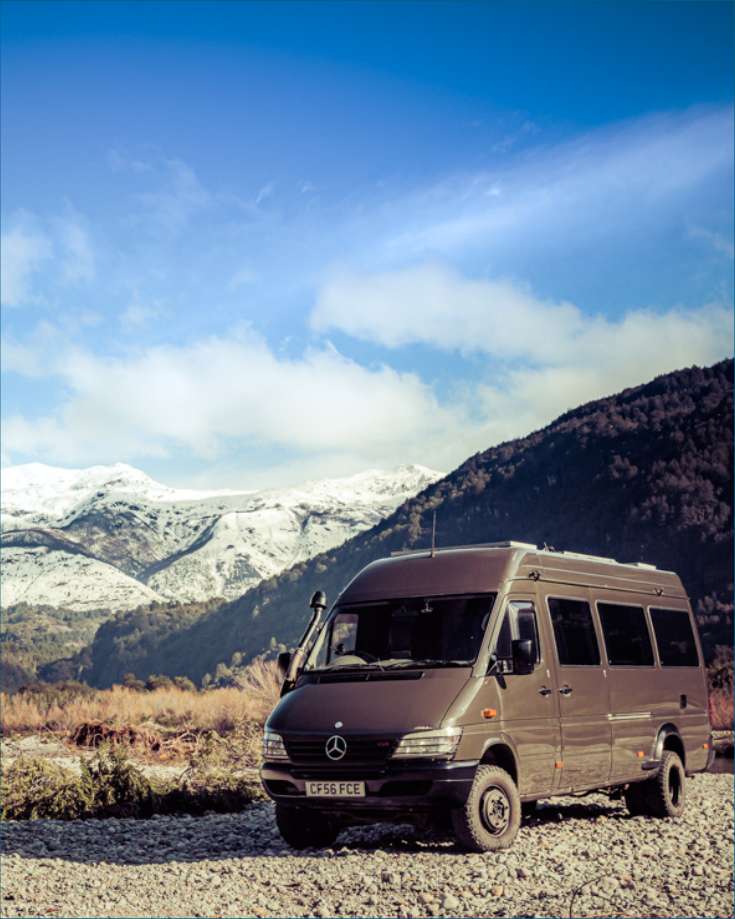
Step-by-Step Guide to Insulating Your Van
Now that you have a better understanding of the different types of insulation materials and their applications, it’s time to dive into a step-by-step guide to insulating your van.
We’ll cover the installation process for flooring, walls, ceiling, and windows and provide tips for working with different insulation materials.
First, install the flooring by measuring and cutting the insulation to fit your van’s unique shapes and curves.
Ensure that there are no exposed foam surfaces and prevent any gaps where moist air could get trapped.
PIR insulation is an excellent choice for van floors, as it is easy to install and provides excellent thermal resistance.
Next, insulate the walls by packing them with polyester eco-wool insulation, which is easy to work with and provides excellent thermal resistance.
Foam insulation can also be used in hard-to-reach areas of the van, where polyester eco-wool insulation may not be suitable.
Use high R-rated insulation materials for the ceiling to provide excellent thermal resistance and keep the van warm in cold temperatures.
Measure and cut the insulation to fit your van’s unique shapes and curves, and ensure that there are no exposed foam surfaces or gaps where moist air could get trapped.
Finally, insulate the windows using Reflectix and thermal curtains, which provide insulation and help with privacy and light control.
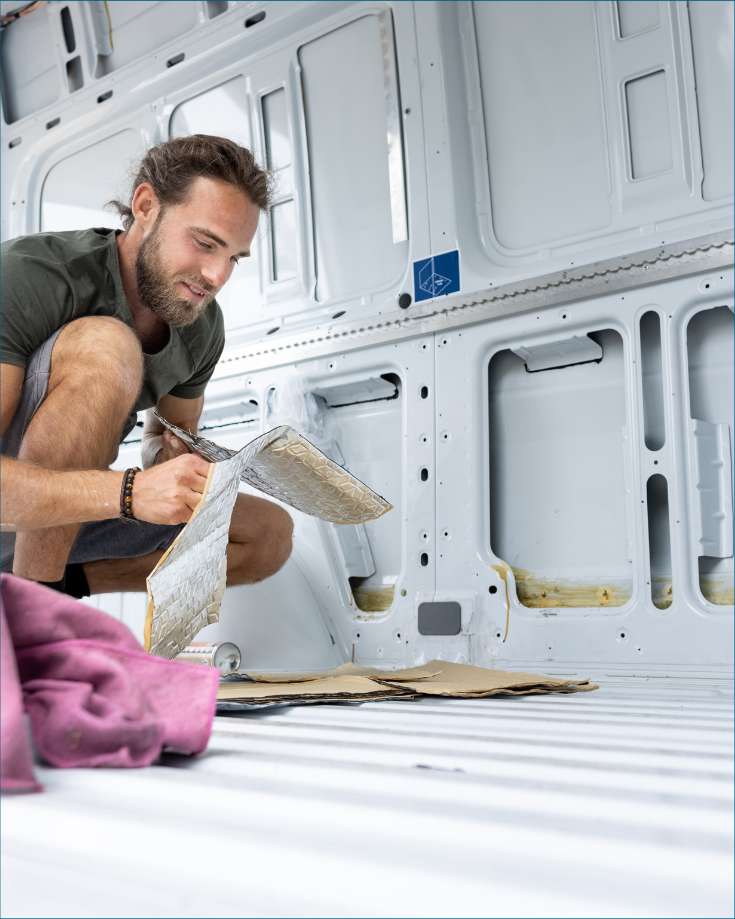
Tips for Adapting Insulation to Different Climates
Adapting your insulation to different climates is essential for ensuring a comfortable and energy-efficient van life experience.
In this section, we’ll provide tips for adjusting your insulation to suit various climates, including using RV skirting, sealing windows, installing multi-pane windows, and more.
RV skirting can help prevent cold air from getting trapped and entering your van through the floors, keeping your living space warm and cozy during winter.
Sealing your windows with silicone and rubber conditioner for weather stripping can also help keep the cold air out and the warm air in.
In hot climates, using removable reflective window coverings can help reflect radiant heat and keep your van cool during the day.
Sound Deadening and Additional Benefits of Insulation
While insulation is primarily used for temperature control, it also provides some sound-deadening properties.
However, if you want to reduce road noise in your van significantly, consider adding Noico’s sound-deadening mat to the bare metal before insulating.
This sound deadener dampens vibrations on the van’s metal panels, providing a quieter ride for an affordable price compared to other brands.
In addition to sound deadening, insulation offers other benefits, such as energy efficiency and comfort in hot and cold weather.
Proper insulation can help reduce heating and cooling costs, making your van life experience more affordable and eco-friendly.
Additional tips for insulating your van include using a heated mattress pad for extra warmth on cold winter nights, sealing slideouts to prevent cold air from entering, and insulating storage bays to protect your belongings from extreme temperatures.

In Conclusion
Insulation helps regulate the temperature in your van and provides sound deadening and additional benefits for a comfortable and energy-efficient van life experience.
By following the tips and guidelines provided in this guide, you’ll be well on your way to enjoying a cozy, quiet, and efficient van life.
Frequently Asked Questions
What is the best form of insulation for a van?
Havelock Wool (sheep wool) is the best van-insulating material. This renewable resource has an impressive R-value of 3.6 and comes in loosely formed batts, making it easy to install and environmentally friendly.
It’s no wonder that Havelock Wool is considered the top choice for mass van insulation.
Is it OK to use fiberglass insulation in a van?
In short, fiberglass insulation is not recommended for use in a van due to its low R-Value, the potential for releasing toxic particles, and its tendency to soak up moisture. It may be a budget-friendly option, but it isn’t the safest or most effective option.
What insulation to use inside a cargo van?
We recommend using a combination of Thinsulate and Reflectix for the best insulation.
The Thinsulate will provide excellent thermal insulation, while the Reflectix will act as a reflective layer to keep out heat in summer months and lock in warm air during winter.
Combined, they can create an effective temperature barrier.
Graham Bogie

Graham is a seasoned marine electrical engineer with two decades of experience designing customized electrical systems for plant machinery and converting campers and overland vehicles. His expertise has led him to author the reputable Campervan Electrics Handbook and become the chief designer of the RV Wiring Design Tool. As a knowledgeable figure in the field, his YouTube channel, blog, Facebook group, and newsletter, offering electrical advice and product reviews, reach more than a million users each year.


